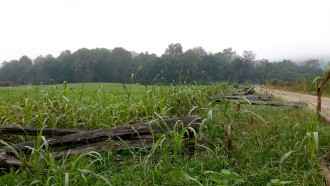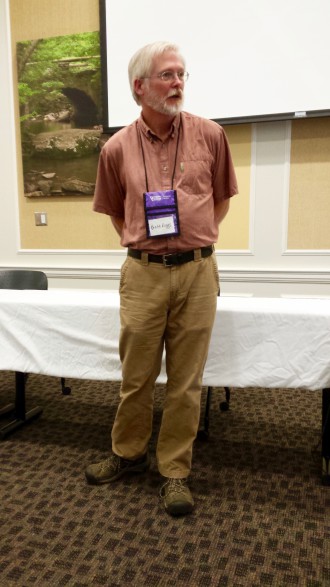ASHEVILLE, N.C.— In a field on the outskirts of Cherokee stands a nondescript mound about 6 feet high, covered in grass and flanked by woods and mountains. Though it appears to be little more than a rise in the land, it is a sacred site for the native people of the Carolina mountains: Kituwah, the Cherokee “mother town” and the epicenter of that tribe’s cosmology.
Here, several dozen people — locals and academics, scientists and students, native and non-native — gathered in late September for Rooted in the Mountains: Valuing our Common Ground, an annual conference where traditional knowledge and Western environmentalism meet.
“This is the heart of the Cherokee world,” Tom Belt, a citizen of Oklahoma’s Cherokee Nation and a Cherokee language instructor at Western Carolina University, told the assembled crowd. “All of our stories began here, where we began as people.”
Over two days, Rooted in the Mountains posited that place plays a key role in spiritual, ecological and physical well-being. Places are not just empty landscapes; they hold people, stories and vibrant ecosystems and give rise to cultural traditions. Honoring places, then, connects individuals with the life around them. It allows them to find their roots.
During lectures at WCU as part of the conference, the Cherokee concept of “duyuk’ dv’ I” took center stage. It means, literally, “the right way,” and encourages putting oneself on the path toward wholeness. Participants examined traditional health practices, cultural revitalization and the role of Western institutions in both hindering and aiding native nations.
The symposium, now in its eighth year, was born out of conversations between people of differing Appalachian traditions.
“My mother and my brother were mountain people,” says conference organizer Lisa Lefler, founder of the Center for Native Health, a nonprofit based in Dillsboro. “They loved the mountains; the mountains allowed them to survive through their childhood into adulthood. My mother used to talk with Tom Belt … for hours about the mountains.”
After her mother died, Lefler knew that conversations with the Cherokee could not end. “We wanted to continue,” she says.
Holding sacred space
“Place is integral to humankind,” said Belt as he stood before Kituwah. “Just as we revere the beginning of life, so also we revere this place.”

Belt grew up in an Oklahoma community that frequently made mention of an ancestral homeland in Southern Appalachia, though few had returned since the forced removal of the Cherokee in 1838. Once, when a teacher asked where he was from, young Belt replied, “North Carolina.” Elders venerated Kituwah, but back in North Carolina, the mound had been all but forgotten.
Kituwah, which means “the dirt belonging to the Creator,” served for centuries as the central village of the Cherokee and may have been inhabited as early as 8000 B.C. The town was razed by the Rutherford expedition in 1776 and fell completely out of Cherokee hands by 1820. For decades, farmers grew corn over the ancient village.
T.J. Holland, cultural resources officer for the Eastern Band of Cherokee Indians — the descendants of those who survived the government’s purge — noted that during his boyhood, the cornfield atop Kituwah was merely a place people drove by. He was with other Cherokee children one day when a woman pointed to the waving tassels and said, “Kids, this is your place — you remember that this is yours.”
In 1996, the ECBI purchased the land back. Immediately, the tribe commissioned archaeological surveys, which revealed the former presence of a council house where the mound stands, in addition to multiple village sites in the surrounding area dating to the 13th century.
“This is the largest archaeological complex in Western North Carolina,” said Brett Riggs, head archaeologist on the project and Sequoyah Distinguished Professor of Cherokee Studies at WCU.
The council house once stood 60 feet in diameter and served as the central location for Cherokee ritual. In its hearth burned the “eternal flame” given to the Cherokee by their creator. When Riggs’ team found evidence of charcoal in the mound, many tribal members intuited that the flame, though buried, had never altogether died.
The story of Kituwah is the story of a nation much restored by rediscovering its sacred ground. “We are of this place,” said Holland, “and we are still in it.”
Rebirth of tradition
At WCU, Belt opened the conference with a Cherokee prayer, welcoming museum curators, Cherokee veterans, federal epidemiologists, local nurses and tribal elders alike into the space. Native ceremony and Western science — often regarded as diametrically opposed — complemented one another at the symposium, as several speakers incorporated both disciplines. WCU seemed a fitting locale, as the campus was once the site of Two Sparrows Town, a Cherokee village, and thus the university could be seen as the newest iteration in a long lineage of educational institutions, according to Riggs.

Keynote speaker Joe Gone, professor of psychology at the University of Michigan and a member of Montana’s Gros Ventre nation, argued that traditional knowledge plays a key role in mental health on his home reservation. As with many native groups, the Gros Ventre suffer high rates of alcohol and drug abuse, he said, but those who recover often assert, “Our culture is our treatment.” Tapping into old ceremonies, Gone found, allowed tribal members to take control of their own lives amid their hardships.
Kevin Jackson, a member of the ECBI, augmented Gone’s thesis with personal experience. He said he struggled with post-traumatic stress disorder upon returning from military service in 2006 and soon turned to drinking. Jackson was raised alienated from his ancestors’ traditions, but it was only when he committed to “tohi” — the Cherokee concept of health — that he was able to rebuild his life. True medicine, he asserted, was not the pills that the Department of Veterans Affairs gave him, but a reaffirmed belonging in his wider Cherokee family. Today, two of his children are in a Cherokee language immersion school and tapping back into their heritage. “I’m living proof that this works,” Jackson said.
Far from rejecting Western tradition, Rooted in the Mountains offered ways in which native and non-native practices can integrate and nourish one another. Symma Finn, a medical anthropologist with the National Institutes of Health, noted that traditional knowledge is just as scientific as academic study: Both are based in observation and evidence but simply stem from different viewpoints. While Onita Bush, a Cherokee elder, shared her firsthand knowledge of plant lore and herbalism, Gwyneira Isaac with the Smithsonian Institution claimed that museums can play a vital role for indigenous nations by carefully tending to collections of sacred objects that have long been stowed away and out of sight.
As much as it was an ideological crossroads, Rooted in the Mountains also spurred personal discovery: finding one’s own path, regardless of upbringing, and tending deeply to heritage and place. With intention and care, traditions at the verge of collapse can come back to life.
“According to traditional views, in order to heal, you have to go home again,” says Lefler, the conference founder. “You have to go to the place that makes you whole.”




Before you comment
The comments section is here to provide a platform for civil dialogue on the issues we face together as a local community. Xpress is committed to offering this platform for all voices, but when the tone of the discussion gets nasty or strays off topic, we believe many people choose not to participate. Xpress editors are determined to moderate comments to ensure a constructive interchange is maintained. All comments judged not to be in keeping with the spirit of civil discourse will be removed and repeat violators will be banned. See here for our terms of service. Thank you for being part of this effort to promote respectful discussion.